Java Reference
In-Depth Information
We can then select from one of several predefined templates to use as a base for our
template or simply to use it "out of the box".
NetBeans gives us the option of using HTML tables or CSS for layout. For most
modern web applications, CSS is the preferred approach. For our example we will
pick a layout containing a header area, a single left column, and a main area.
After clicking on
Finish
, NetBeans automatically generates our template, along with
the necessary CSS files.
The automatically generated template looks like this:
<?xml version='1.0' encoding='UTF-8' ?>
<!DOCTYPE html PUBLIC "-//W3C//DTD XHTML 1.0 Transitional//EN"
"http://www.w3.org/TR/xhtml1/DTD/xhtml1-transitional.dtd">
<html xmlns="http://www.w3.org/1999/xhtml"
xmlns:ui="http://java.sun.com/jsf/facelets"
xmlns:h="http://java.sun.com/jsf/html">
<h:head>
<meta http-equiv="Content-Type" content="text/html;
charset=UTF-8" />


